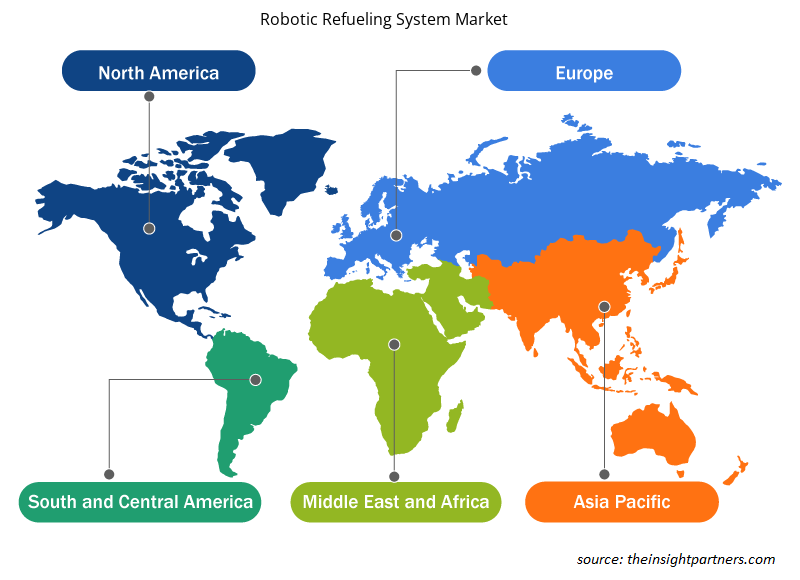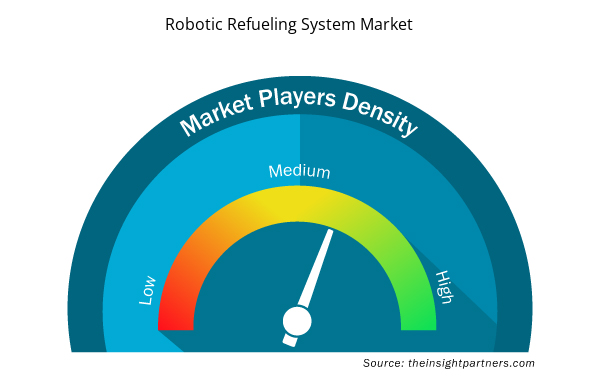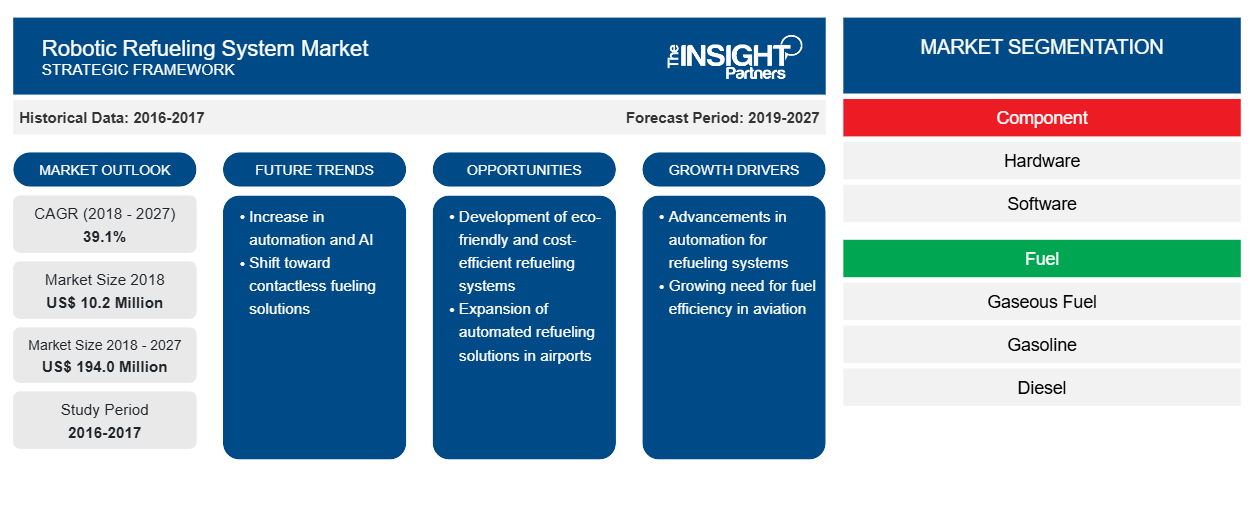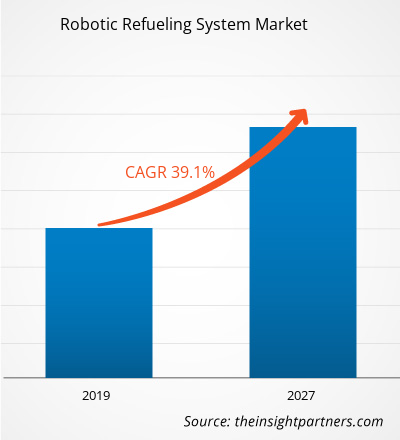2018 年全球机器人加油系统市场规模为 1020 万美元,预计在 2019 年至 2027 年的预测期内,复合年增长率为 39.1%,到 2027 年将达到 1.94 亿美元。
由于自动化趋势持续发展和持续的先进技术改进,各种终端用户行业对机器人的需求大幅加速,这主要推动了机器人加油系统市场的发展。美国是这项服务的早期和主要采用者,并且仍处于增长阶段,实施了多种与机器人加油系统相关的工具和技术。一些全球最大的商业公司的存在,加上该地区的激烈竞争,推动了终端用户行业对机器人加油系统服务的需求。此外,美国也被认为是创新的中心,因此,技术变革首先发生在这个地区,然后蔓延到其他地区。机器人加油系统市场正逐渐普及到其他发达和发展中经济体,包括欧洲和中东和非洲。此外,亚太地区的国家正在经历工业部门的高速增长,从而推动了机器人加油系统市场的增长
市场洞察
低运营成本和分配不同燃料的灵活性将成为机器人加油系统市场增长的催化剂
几十年来,加油泵一直由人工操作,因此增加了管理加油站和加油泵的总运营成本。已经指派操作员负责加油和管理财务运营。机器人加油站将消除人工对潜在危险的石化烟雾的需求,避免驾驶员在加油过程中暴露在极冷或极热的温度下,并降低与全方位服务加油站相关的劳动力成本。此外,给柴油车加汽油或反之亦然一直是加油时最粗心的错误。机器人加油系统消除了发生错误加油事故的可能性,因为每辆车都有一个 RFID 标签,可以告知加油站使用的燃料类型,如汽油、柴油或天然气。
定制此报告以满足您的需求
您可以免费定制任何报告,包括本报告的部分内容、国家级分析、Excel 数据包,以及为初创企业和大学提供优惠和折扣
- 获取此报告的关键市场趋势。这个免费样品将包括数据分析,从市场趋势到估计和预测。
采矿业确保机器人加油系统市场强劲的增长率
通常,加油设施始终由至少一个人管理,在采矿业中,卡车每天最多要花一个小时的时间前往远离矿坑的偏远地区加油。自动加油或机器人加油可以节省大量时间,因为自动/机器人解决方案不需要人员配备;因此,加油站可以放置在矿坑内或环路上,从而可以显着提高车队的生产率。同时,采矿公司也在考虑克服与安全、保障和危险采矿条件相关的微观经济因素,以确保其员工的健康。尽管根深蒂固的机器人加油影响尚未获得行业的支持,但许多公司已开始使用集装箱式机器人加油站来减轻矿山和生产现场危险工作环境带来的风险。采矿业使用机器人加油系统目前是为了保障危险和高风险作业中的人员安全。成本优化是采矿业借助机器人技术探索的另一个领域。
组件洞察
机器人加油系统的主要组件包括硬件和软件。硬件部分包括各种传感器和系统,例如车辆定位系统、控制系统、机械臂、燃料分配系统和传感器,例如位置传感器和接近传感器。机器人加油系统的关键组件之一是软件。软件只是引导机器人离开车辆并将燃油喷嘴完美插入燃油入口的算法。
燃料洞察
几十年来,汽油、柴油、天然气和生物柴油等化石燃料一直是许多机械和车辆的驱动力。道路上行驶的大多数车辆主要使用汽油,因为与柴油相比,汽油的废气排放量较少。
行业垂直洞察
各行各业都考虑使用机器人加油系统来消除加油过程中产生的任何风险,并避免人类接触有害的石化烟雾。航空航天和国防是机器人加油系统市场最大的垂直行业,因为美国和欧洲地区有多个试点项目。
报告范围
据观察,一些市场举措是全球机器人加油系统市场最常采用的策略。以下列出了一些最近的市场举措:
2018 年:Fanuc 公司宣布通过建设三家新工厂来扩大其生产能力。新工厂旨在提高 ROBOT、ROBOSHOT 和 ROBOCUT 的产能。2018
年:Fuelmatics 收到一家美国石油公司的两台 Fuelmatics 5000 订单,该公司在美国各州拥有大型加油站。这些系统将安装在肯尼迪机场附近的加油站供公众使用。2018 年
:KUKA、MHP 和 Munich 代表着一个愿景,即一种新的智能工厂即服务。新服务使用工业 4.0 和数字化,从而实现新的制造方法并需要新的商业模式。
机器人加油系统市场区域洞察
Insight Partners 的分析师已详细解释了预测期内影响机器人加油系统市场的区域趋势和因素。本节还讨论了北美、欧洲、亚太地区、中东和非洲以及南美和中美洲的机器人加油系统市场细分和地理位置。

- 获取机器人加油系统市场的区域特定数据
机器人加油系统市场报告范围
| 报告属性 | 细节 |
|---|---|
| 2018 年市场规模 | 1020 万美元 |
| 2027 年市场规模 | 1.94 亿美元 |
| 全球复合年增长率(2018 - 2027) | 39.1% |
| 史料 | 2016-2017 |
| 预测期 | 2019-2027 |
| 涵盖的领域 | 按组件
|
| 覆盖地区和国家 | 北美
|
| 市场领导者和主要公司简介 |
|
市场参与者密度:了解其对商业动态的影响
机器人加油系统市场正在快速增长,这得益于终端用户需求的不断增长,这些需求源于消费者偏好的不断变化、技术进步以及对产品优势的认识不断提高等因素。随着需求的增加,企业正在扩大其产品范围,进行创新以满足消费者的需求,并利用新兴趋势,从而进一步推动市场增长。
市场参与者密度是指在特定市场或行业内运营的企业或公司的分布情况。它表明在给定市场空间中,相对于其规模或总市场价值,有多少竞争对手(市场参与者)存在。
在机器人加油系统市场运营的主要公司有:
- 斯科特
- 库卡
- 发那亚克
- 燃油系统
- 内斯特
免责声明:上面列出的公司没有按照任何特定顺序排列。

- 获取机器人加油系统市场顶级关键参与者概览
全球机器人加油系统市场细分
全球机器人加油系统市场 – 按组件划分
- 硬件
- 软件
全球机器人加油系统市场 – 按燃料分类
- 气体燃料
- 汽油
- 柴油机
- 其他的
全球机器人加油系统市场 – 按垂直行业划分
- 航空航天和国防
- 汽车
- 建造
- 石油和天然气
- 矿业
- 其他的
全球机器人加油系统市场 – 按地域划分
北美
- 我们
- 加拿大
- 墨西哥
欧洲
- 法国
- 德国
- 英国
- 俄罗斯
- 意大利
- 欧洲其他地区
亚太地区 (APAC)
- 中国
- 印度
- 日本
- 澳大利亚
- 韩国
- 亚太地区其他地区
中东和非洲 (MEA)
- 南非
- 沙特阿拉伯
- 阿联酋
- MEA 其他地区
南美洲
- 巴西
- 阿根廷
- SAM 其余部分
全球机器人加油系统市场 - 公司简介
- 斯科特
- 库卡
- 发那科
- 燃油系统
- 内斯特
- 罗泰克工程公司
- 俄罗斯天然气工业股份公司
- 矿山能源解决方案
- Plug Power 公司
- 萧氏发展有限公司
- 历史分析(2 年)、基准年、预测(7 年)及复合年增长率
- PEST 和 SWOT 分析
- 市场规模价值/数量 - 全球、区域、国家
- 行业和竞争格局
- Excel 数据集


- Explosion-Proof Equipment Market
- Hot Melt Adhesives Market
- Electronic Shelf Label Market
- Cling Films Market
- Lyophilization Services for Biopharmaceuticals Market
- Clear Aligners Market
- Authentication and Brand Protection Market
- Artificial Intelligence in Defense Market
- Flexible Garden Hoses Market
- Microcatheters Market

Report Coverage
Revenue forecast, Company Analysis, Industry landscape, Growth factors, and Trends

Segment Covered
This text is related
to segments covered.

Regional Scope
North America, Europe, Asia Pacific, Middle East & Africa, South & Central America

Country Scope
This text is related
to country scope.
Trends and growth analysis reports related to Electronics and Semiconductor : READ MORE..
The List of Companies
- Scott
- KUKA
- Fanuac
- Fuelmatics
- Neste
- Rotec Engineering
- Gazprom Neft
- Mine Energy Solutions
- Plug Power, Inc.
- Shaw Development LLC
The Insight Partners performs research in 4 major stages: Data Collection & Secondary Research, Primary Research, Data Analysis and Data Triangulation & Final Review.
- Data Collection and Secondary Research:
As a market research and consulting firm operating from a decade, we have published and advised several client across the globe. First step for any study will start with an assessment of currently available data and insights from existing reports. Further, historical and current market information is collected from Investor Presentations, Annual Reports, SEC Filings, etc., and other information related to company’s performance and market positioning are gathered from Paid Databases (Factiva, Hoovers, and Reuters) and various other publications available in public domain.
Several associations trade associates, technical forums, institutes, societies and organization are accessed to gain technical as well as market related insights through their publications such as research papers, blogs and press releases related to the studies are referred to get cues about the market. Further, white papers, journals, magazines, and other news articles published in last 3 years are scrutinized and analyzed to understand the current market trends.
- Primary Research:
The primarily interview analysis comprise of data obtained from industry participants interview and answers to survey questions gathered by in-house primary team.
For primary research, interviews are conducted with industry experts/CEOs/Marketing Managers/VPs/Subject Matter Experts from both demand and supply side to get a 360-degree view of the market. The primary team conducts several interviews based on the complexity of the markets to understand the various market trends and dynamics which makes research more credible and precise.
A typical research interview fulfils the following functions:
- Provides first-hand information on the market size, market trends, growth trends, competitive landscape, and outlook
- Validates and strengthens in-house secondary research findings
- Develops the analysis team’s expertise and market understanding
Primary research involves email interactions and telephone interviews for each market, category, segment, and sub-segment across geographies. The participants who typically take part in such a process include, but are not limited to:
- Industry participants: VPs, business development managers, market intelligence managers and national sales managers
- Outside experts: Valuation experts, research analysts and key opinion leaders specializing in the electronics and semiconductor industry.
Below is the breakup of our primary respondents by company, designation, and region:

Once we receive the confirmation from primary research sources or primary respondents, we finalize the base year market estimation and forecast the data as per the macroeconomic and microeconomic factors assessed during data collection.
- Data Analysis:
Once data is validated through both secondary as well as primary respondents, we finalize the market estimations by hypothesis formulation and factor analysis at regional and country level.
- Macro-Economic Factor Analysis:
We analyse macroeconomic indicators such the gross domestic product (GDP), increase in the demand for goods and services across industries, technological advancement, regional economic growth, governmental policies, the influence of COVID-19, PEST analysis, and other aspects. This analysis aids in setting benchmarks for various nations/regions and approximating market splits. Additionally, the general trend of the aforementioned components aid in determining the market's development possibilities.
- Country Level Data:
Various factors that are especially aligned to the country are taken into account to determine the market size for a certain area and country, including the presence of vendors, such as headquarters and offices, the country's GDP, demand patterns, and industry growth. To comprehend the market dynamics for the nation, a number of growth variables, inhibitors, application areas, and current market trends are researched. The aforementioned elements aid in determining the country's overall market's growth potential.
- Company Profile:
The “Table of Contents” is formulated by listing and analyzing more than 25 - 30 companies operating in the market ecosystem across geographies. However, we profile only 10 companies as a standard practice in our syndicate reports. These 10 companies comprise leading, emerging, and regional players. Nonetheless, our analysis is not restricted to the 10 listed companies, we also analyze other companies present in the market to develop a holistic view and understand the prevailing trends. The “Company Profiles” section in the report covers key facts, business description, products & services, financial information, SWOT analysis, and key developments. The financial information presented is extracted from the annual reports and official documents of the publicly listed companies. Upon collecting the information for the sections of respective companies, we verify them via various primary sources and then compile the data in respective company profiles. The company level information helps us in deriving the base number as well as in forecasting the market size.
- Developing Base Number:
Aggregation of sales statistics (2020-2022) and macro-economic factor, and other secondary and primary research insights are utilized to arrive at base number and related market shares for 2022. The data gaps are identified in this step and relevant market data is analyzed, collected from paid primary interviews or databases. On finalizing the base year market size, forecasts are developed on the basis of macro-economic, industry and market growth factors and company level analysis.
- Data Triangulation and Final Review:
The market findings and base year market size calculations are validated from supply as well as demand side. Demand side validations are based on macro-economic factor analysis and benchmarks for respective regions and countries. In case of supply side validations, revenues of major companies are estimated (in case not available) based on industry benchmark, approximate number of employees, product portfolio, and primary interviews revenues are gathered. Further revenue from target product/service segment is assessed to avoid overshooting of market statistics. In case of heavy deviations between supply and demand side values, all thes steps are repeated to achieve synchronization.
We follow an iterative model, wherein we share our research findings with Subject Matter Experts (SME’s) and Key Opinion Leaders (KOLs) until consensus view of the market is not formulated – this model negates any drastic deviation in the opinions of experts. Only validated and universally acceptable research findings are quoted in our reports.
We have important check points that we use to validate our research findings – which we call – data triangulation, where we validate the information, we generate from secondary sources with primary interviews and then we re-validate with our internal data bases and Subject matter experts. This comprehensive model enables us to deliver high quality, reliable data in shortest possible time.


 获取此报告的免费样本
获取此报告的免费样本